Introduction
Since the mid-1950s, ballistic missile submarines have been pivotal to the United States’ nuclear arsenal. Today, these submarines bear a larger quantity of nuclear warheads compared to the intercontinental ballistic missile (ICBM) force.
U.S. Ballistic missile submarines, also known as “boomers” or FBMs (Fleet Ballistic Missile submarines, designated SSBN) are submarines capable of launching strategic nuclear weapons upon short notice.
| Class name | Built | Comm. | Displ.(Sub.) (t) | Missiles |
|---|---|---|---|---|
| George Washington | 5 | 1959 | 6,700 | 16 x Polaris A1 Polaris A3 |
| Ethan Allen | 5 | 1961 | 7,880 | 16 x Polaris A2 Polaris A3 |
| Lafayette | 9 | 1963 | 8,260 | 16 x Polaris A2 Polaris A3 Poseidon C3 |
| James Madison | 10 | 1964 | 8,240 | 16 x Polaris A3 Poseidon C3 Trident C4 |
| Benjamin Franklin | 12 | 1965 | 8,250 | 16 x Polaris A3 Poseidon C3 Trident C4 |
| Ohio | 18 | 1981 | 18,750 | 24 x Trident C4 Trident D5 |
They were specifically engineered to form one of the three components of the U.S. strategic nuclear triad which also encompassed the Strategic Air Command’s bombers and a variety of Army and Air Force land-based intercontinental ballistic missiles.
Their mobility, stealth, and endurance compared to their land and air counterparts make them practically undetectable and, therefore, a powerful strategic asset.
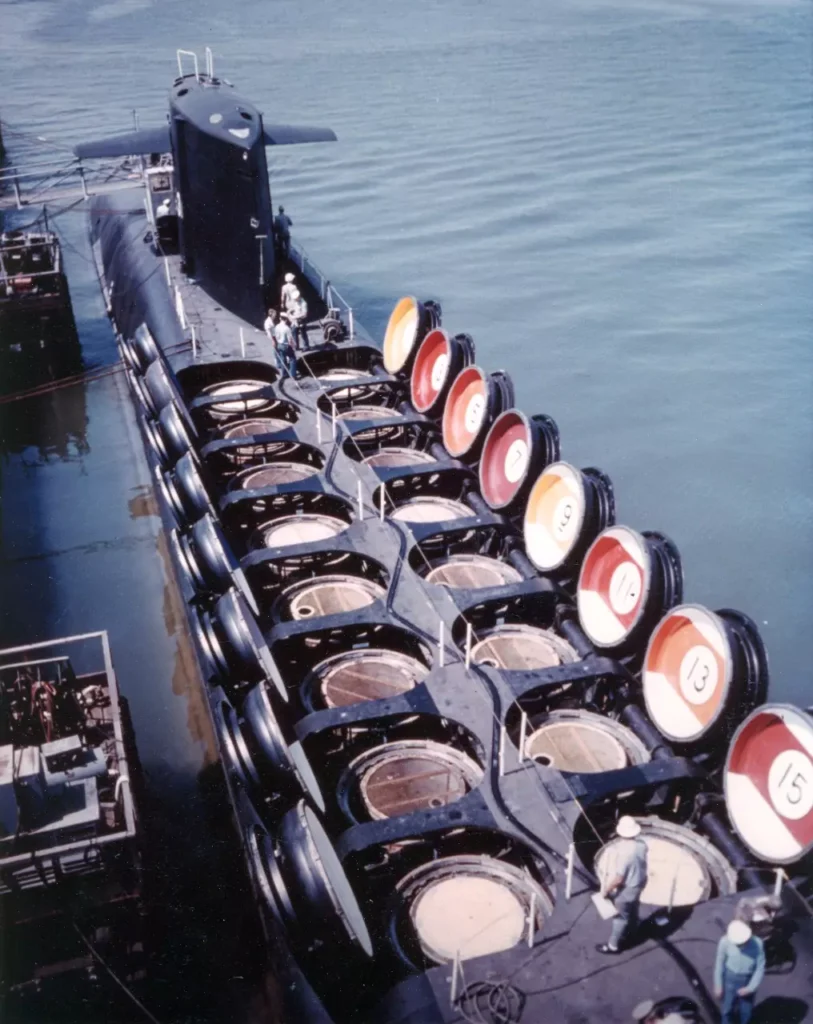
FBMs rank among the world’s largest submarines. The Ohio class, for instance, surpasses even a post-World War I era battleship in length and weight.
These submarines are also the busiest, staying docked only long enough to switch crews and resupply. They undertake the longest patrols compared to other submarines. Consequently, they possess the most comprehensive crew facilities among Navy submarines, with the Ohio class housing two libraries and music headphones for every bunk.
A little history
In the initial years, U.S. Navy attack submarines were equipped with the Regulus cruise missiles, marking the Navy’s first foray into strategic missile deployment.
This was followed by the introduction of the George Washington class, the Navy’s inaugural Fleet Ballistic Missile (FBM) submarines. The design of this class not only shaped the blueprint for subsequent U.S. Navy FBMs but also influenced the Soviet Union’s Yankee class ballistic missile submarines. The U.S. has since deployed at least four primary classes of FBMs and two subclasses.
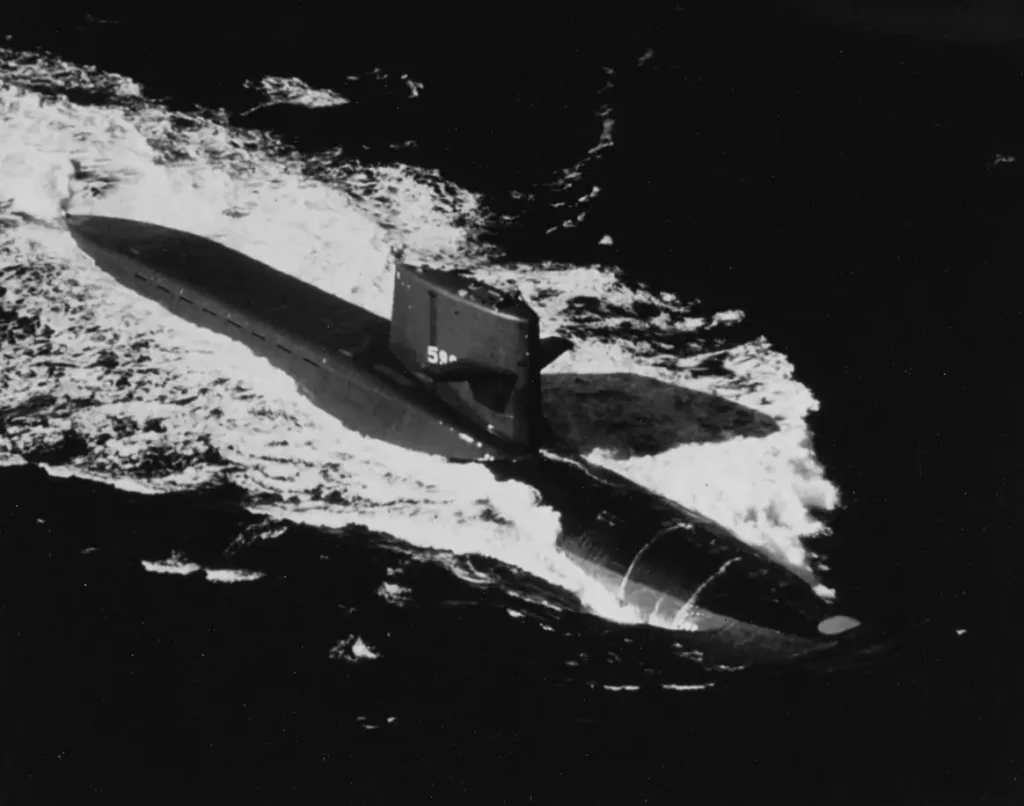
At present, the Navy’s FBM force comprises solely the 14 Ohio class submarines and their Trident II missiles. Previous classes such as George Washington, Ethan Allen, Lafayette, Madison, and Benjamin Franklin, along with the Polaris and Poseidon missile systems, have been retired.
While FBMs represent the primary strategic nuclear submarines, the development of the Tomahawk cruise missile has rejuvenated the nuclear capability of attack submarines. Currently, under the existing nuclear policy, the Tomahawks are conventionally armed. Still, this policy retains the Navy’s capacity to deploy nuclear-armed Tomahawks in a significant crisis. If this were to occur, the Los Angeles class of attack submarines would rival the power of the early George Washington class of FBMs.
Names
The 41 Polaris strategic missile submarines, constructed from 1959 to 1967, bear the names of “famous Americans”. This broad category encompassed not only notable figures from the continental U.S. but also extended to prominent South American and Hawaiian leaders, as well as European individuals who significantly contributed to the U.S. War of Independence.
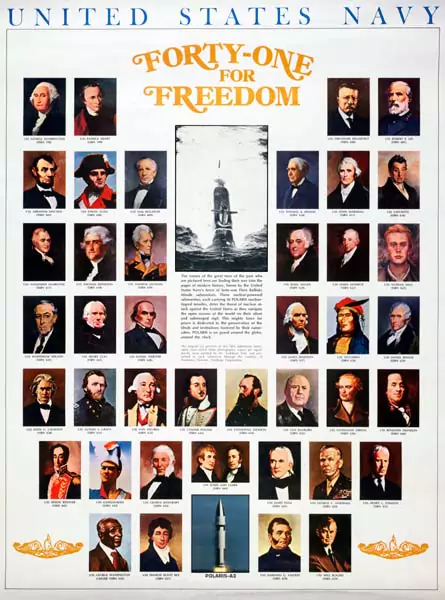
This tradition underwent a shift starting in 1981. With the introduction of the Trident submarines, which were built until 1997, the U.S. Navy began naming these vessels after the States of the Union. This new convention had previously been reserved for battleships and, later, guided missile cruisers (CGN 36-41) and attack submarines (SSN 22 and 774-). The first Trident submarine to follow this new naming protocol was the SSBN 726, christened Ohio.
However, there was one notable exception to these naming conventions. On September 27, 1983, a deviation was made when the SSBN 730 was named in honor of the late Senator Henry M. (Scoop) Jackson, a staunch supporter of nuclear and defense programs.
Construction
The Trident and the majority of the U.S. Polaris-Poseidon submarines were constructed by General Dynamics Electric Boat Division located in Groton, Connecticut. They built all 18 Trident submarines and 17 out of the 41 Polaris-Poseidon submarines.
Besides Electric Boat, SSBNs were built by the Mare Island Naval Shipyard, Newport News Shipbuilding, and the Portsmouth Naval Shipyard.

The execution of the Polaris submarine program was a remarkable feat in U.S. submarine manufacturing. A total of 41 submarines were constructed in just under seven and a half years, following an extremely accelerated developmental phase.

Besides the Polaris submarines, the Navy also finished building 17 other nuclear-powered submarines during the same period. This brings the impressive construction rate to nearly 8 submarines each year.
Missiles
The first batch of five submarines, all part of the George Washington class, were outfitted with 16 Polaris A-1 missiles each. The inaugural Polaris A-1 deterrent patrol was undertaken by George Washington on November 15, 1960. This was followed by another five submarines belonging to the Ethan Allen class and eight Lafayette class submarines, which were equipped with Polaris A-2 missiles.

However, the Polaris missile series has since been retired from the U.S. submarine fleet. The final patrols for the Polaris A-1, A-2, and A-3 missiles concluded in October 1965, June 1974, and May 1981, respectively.
The Lafayette-class submarines were initially deployed with the Polaris A-2 missile, while newer class units were equipped with the Polaris A-3 missile. Between 1970 and 1978, all submarines from the Lafayette, James Madison, and Benjamin Franklin classes were converted to launch the Poseidon missile.

Post this, the Benjamin Franklin-class submarines were chosen for modification to accommodate the launch of the Trident C-4 missile. The first Trident SSBN, the Francis Scott Key, was modified between 1978 and 1979 and embarked on the first Trident patrol on October 20, 1979. All 12 modifications were set to be completed by 1983.
The initial eight Ohio-class submarines were equipped with Trident C-4 missile capabilities, with the ninth ship onwards being fitted with the more advanced Trident D-5 missile. The first Trident C-4 launch from the Ohio class took place on January 17, 1982.
The final Poseidon C-3 patrols concluded in October 1991.
Operation
Deterrent patrols
The history of U.S. strategic missile submarines began with the inaugural voyage of the USS George Washington on November 15, 1960. Armed with 16 Polaris A-1 missiles, George Washington conducted the first ballistic missile patrol, marking a crucial development in the nation’s defense capabilities. This initial patrol set a groundbreaking record for underwater endurance, with the submarine remaining submerged for a total of 66 days and 10 hours.
By April 4, 1987, the U.S. Navy had completed 2,500 strategic deterrent patrols, with the milestone patrol carried out by the Mariano G. Vallejo. Only five years later, in 1992, the Submarine Force commemorated the completion of 3,000 patrols, with the USS Tennessee (SSBN 734) at the helm of this landmark voyage.
Notably, the USS Tennessee would again make history in 2014, as it marked the 4,000th patrol by a U.S. Navy SSBN. This impressive rate equates to an average of roughly 95 patrols per year across just under 32 years.

As of that moment, U.S. ballistic missile submarines had completed the following deterrent patrols:
- 1,245 Polaris
- 1,182 Poseidon
- 397 Trident C-4 back fit in older submarines
- 481 Trident C-4 in Ohio-class submarines
- 695 Trident D-5 in Ohio-class submarines
Homeports and refit sites
Over the decades, strategic missile submarines have been homeported across various locations.
Atlantic-based Polaris submarines operated from New London, Connecticut, and Charleston, South Carolina, with additional support bases established at Holy Loch in Scotland and Rota, Spain.
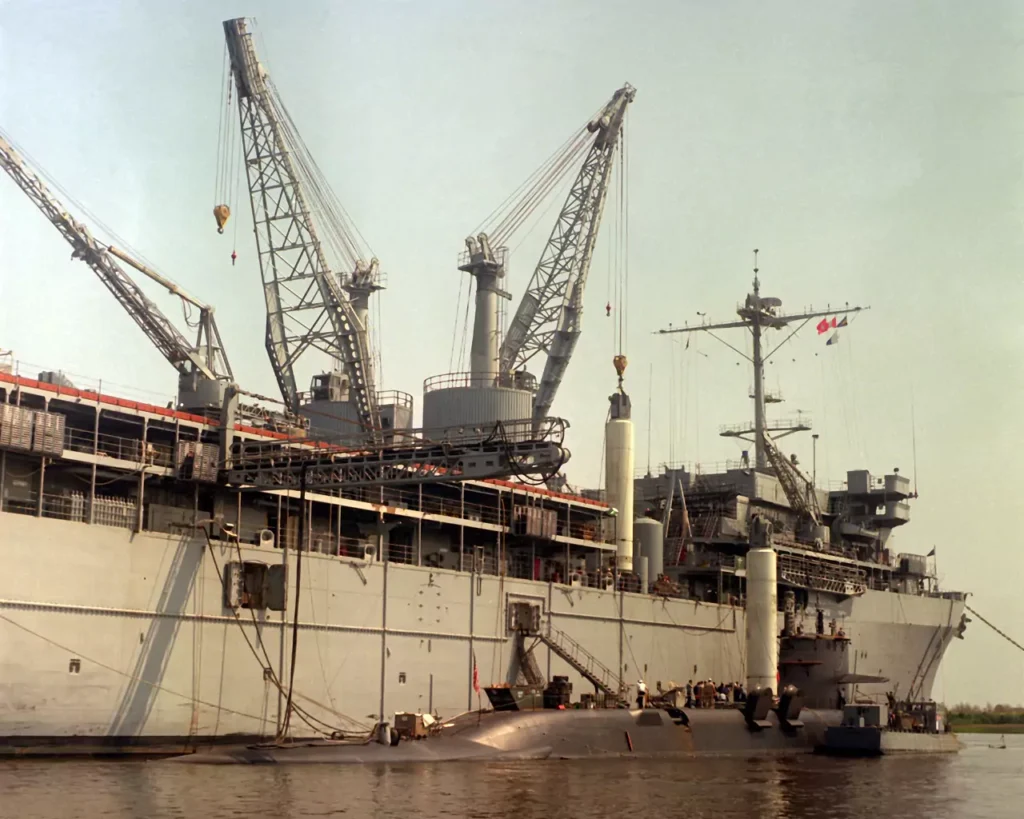
Pacific-based Polaris submarines were stationed at Pearl Harbor, Hawaii, and refitted at Apra Harbor, Guam. However, both Holy Loch, established in 1961, and Apra Harbor, have since closed down.
Today, the Trident SSBN force, the successors of the Polaris submarines, patrol from their bases in Bangor, Washington, for North Pacific duties, and Kings Bay, Georgia, for North Atlantic operations.
Manning
The United States fleet of ballistic missile submarines adopts a unique operational strategy termed the “two-crew” concept. This approach entails having two separate crews – Blue and Gold – who alternate their deployments on the submarine.
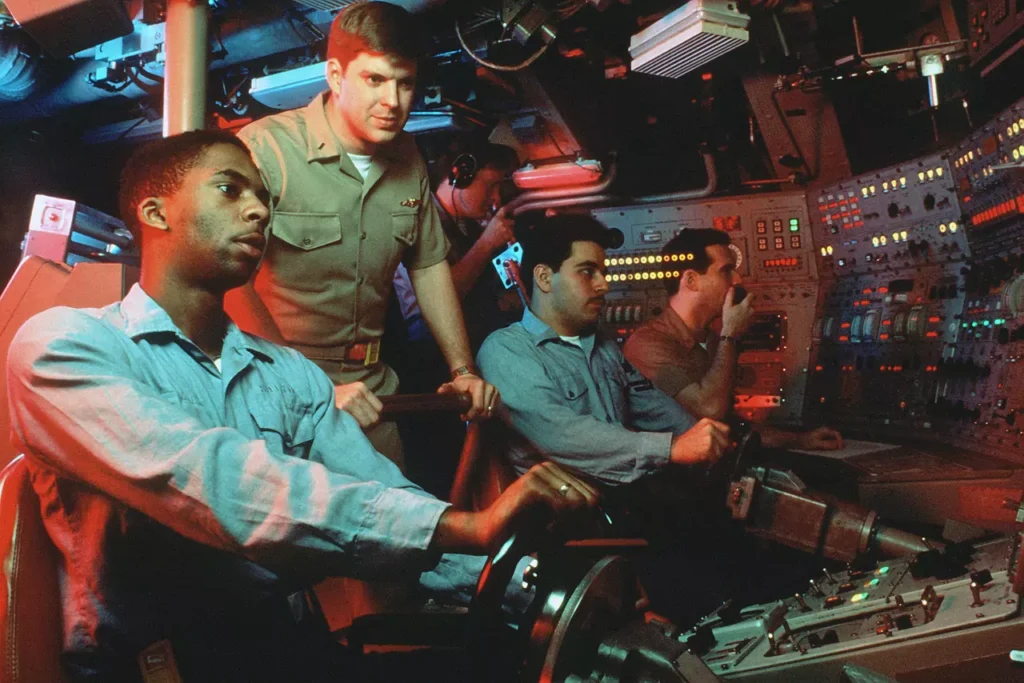
Each crew, in essence, serves as a fully operational team, alternating their roles between on-sea and off-sea activities. While one crew is at sea, embarking on deployments that can last up to 70 days, the other crew remains ashore. During this period, the on-land crew engages in various activities such as simulator-based training, medical treatments, leave periods, and other necessary shore-based tasks.
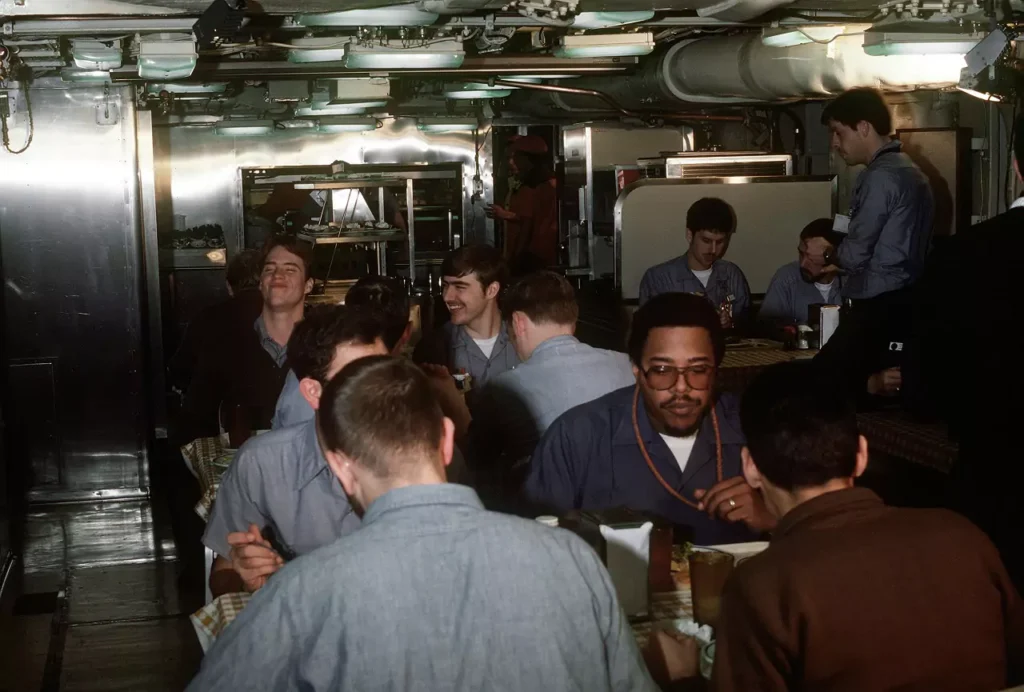
Upon completion of a patrol, there’s a formal change of command ceremony. The incoming crew, ready for sea deployment, takes over from the outgoing crew. This outgoing crew, referred to as the “off-crew,” then leverages the ensuing off-patrol period to prepare and build readiness for their next deployment.
Decommission
From 1967 to 1980, the sea-based arm of the U.S. strategic Triad witnessed a consistent reduction in the number of Ballistic Missile Submarines (SSBNs) and their launch tubes. This period peaked with 41 SSBNs, equipped with 656 Polaris and subsequent missile variants. This significant decrease was somewhat offset by advancements in accuracy and the rising number of Multiple Independently targeted Re-entry Vehicles (MIRVs), especially with the introduction of Poseidon and later Trident missiles.
As more Ohio-class submarines were built, older SSBNs were gradually retired in line with the provisions of the U.S.-Soviet SALT agreements. Decommissioning the last of the 41 initial Polaris-Poseidon ballistic missile submarines, built from 1959 to 1967, began in 1986, at a rate of two to three per year, a process which accelerated notably in 1991.
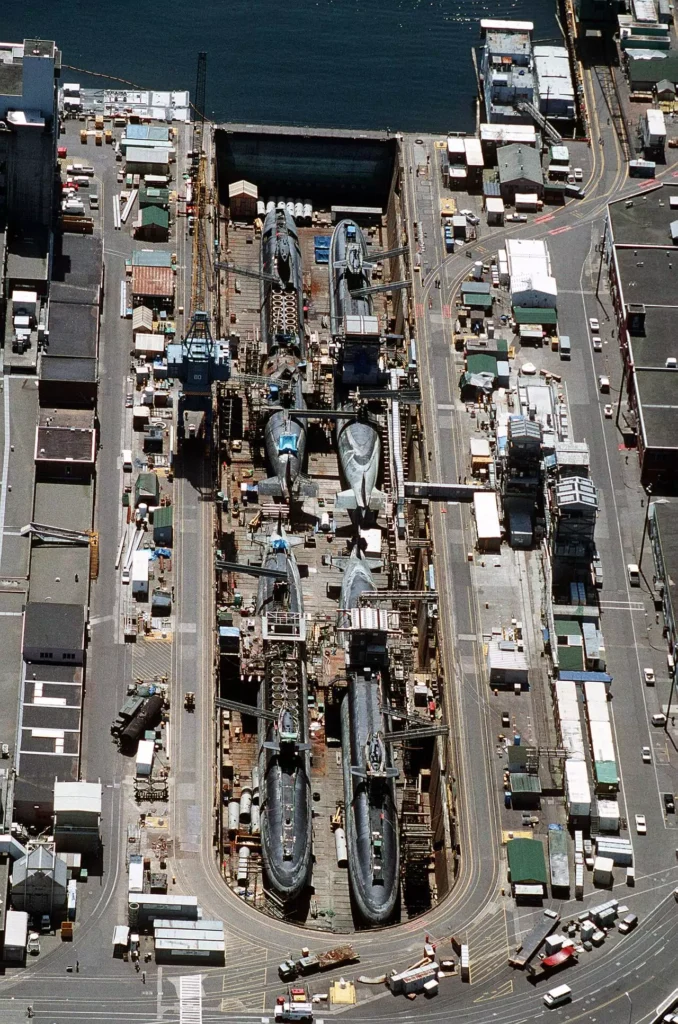
The Lafayette-class submarines, equipped with Poseidon missiles, ceased operations on October 15, 1991, marked by the return of the Kamehameha and Ulysses S. Grant to New London, Connecticut. Following this, deactivation began for the ten Poseidon submarines, barring two units that were being converted into special operations/transport submarines.
Two decommissioned SSBNs, the Daniel Webster and Sam Rayburn, were conserved and immobilized in Charleston, South Carolina, to serve as Moored Training Ships (MTS) for nuclear propulsion operators. Meanwhile, the 12 Benjamin Franklin-class submarines retrofitted with Trident C-4 missiles were phased out by the mid-1990s.
Interestingly, the very last Polaris submarine to be retired was the Kamehameha (SSN 642) in 2002, which had served as a transport submarine.
Defueling an SSBN
Dismantling these retired submarines was a time-intensive process, taking over a year. Prior to decommissioning, the SSBNs stood down, with their reactors defueled and removed, alongside other radioactive and hazardous materials. These reactors were temporarily buried at Hanford, Washington.
East Coast decommissioned submarines were defueled and subsequently towed to Puget Sound for the removal and burial of their reactor compartments and scrapping. Useful material was also stripped from these submarines to serve other fleet purposes.
As of 1999, the average cost for decommissioning and partially dismantling a nuclear SSBN was estimated at $32 million.
Further reading
- George Washington-Class (SSBN-598) Ballistic Missile Submarines
- Ethan Allen-Class (SSBN-608) Ballistic Missile Submarines
- Lafayette-Class (SSBN-616) Ballistic Missile Submarines
- James Madison-Class (SSBN-627) Ballistic Missile Submarines
- Benjamin Franklin-Class (SSBN-640) Ballistic Missile Submarines
- Ohio-Class (SSBN-726) Ballistic Missile Submarines
Bibliography
- Polmar, N., Moore, K. J. (2014). Cold War Submarines: The Design and Construction of U.S. and Soviet Submarines. United States: Potomac Books, Incorporated.
- Polmar, N. (1987). The Naval Institute Guide to the Ships and Aircraft of the U.S. Fleet, 14th Edition. United States: Naval Institute Press.
- Polmar, N. (1993). The Naval Institute Guide to the Ships and Aircraft of the U.S. Fleet, 15th Edition. United States: Naval Institute Press.
- Gibson, J. N. (1996). Nuclear Weapons of the United States: An Illustrated History. United States: Schiffer Publishing.
- Adcock, A. (1993). U.S. Ballistic Missile Subs in Action. United States: Squadron/Signal Publications.